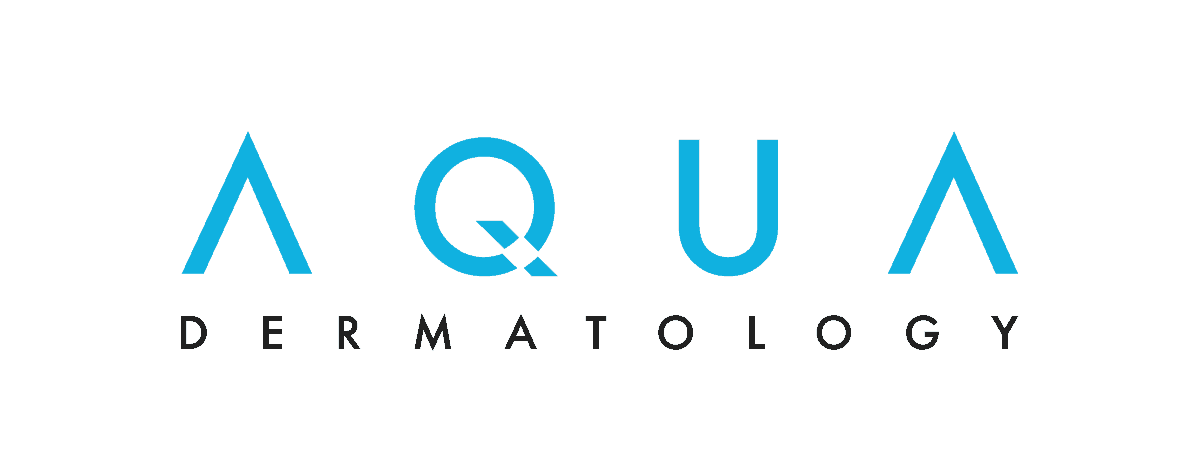Birthmarks
Call (877) 900-3223
Birthmarks
Pigmented Birthmarks
Vascular Birthmarks
What To Do About Birthmarks
A birthmark is a mark that appears on the skin at birth or shortly thereafter. Birthmarks may be found anywhere on the skin and vary in size, shape, and color. They may be large or small, flat or raised. They may have regular or irregular borders and differ in color from tan to brown, black, blue, pink, red, or purple.
Birthmarks seem to occur randomly; there is no known cause. They are not usually painful or a sign of anything wrong. Some eventually go away on their own, while others are permanent. If your child is bothered by or self-conscious about a birthmark, your dermatologist can let you know if it can be treated and what your options are.
There are two main types of birthmarks: pigmented and vascular. Pigmented birthmarks are caused by excess skin pigment cells (melanocytes) in the affected area, while vascular birthmarks develop when there are excess blood vessels.
Pigmented Birthmarks
These types of birthmarks happen when pigment clusters in one part of your skin. There are several types of pigmented birthmarks: café-au-lait spots, Mongolian spots, and moles.
CAFÉ-AU-LAIT SPOTS
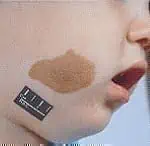
Café-au-lait is French for “coffee with milk,” which describes the usual color of these common spots. Typically flat and oval-shaped, they look light brown on light skin or black on dark skin. The spots may fade with age but usually do not go away completely.
One café-au-lait birthmark is not cause for concern, but if your child has multiple spots, you should have a dermatologist evaluate them. This could be a sign of neurofibromatosis, a genetic disorder that causes abnormal cell growth of nerve tissues.
If treatment is desired for cosmetic reasons, laser treatment may be an option to help to reduce the size and color of café-au-lait spots. Discuss the risks of the procedure and chance for recurrence with your dermatologist.
MONGOLIAN SPOTS

These types of spots are flat and bluish-gray, like a bruise. They mostly appear on the lower back or buttocks of babies with darker skin, such as those of Asian, African, Hispanic, Native American, and Southern European descent. Most Mongolian spots fade within a few years, but some do not.
No treatment is necessary or recommended when Mongolian spots are normal birthmarks. In some instances, however, the spots are a sign of an underlying disorder, and in those cases treatment for that problem will likely be recommended. Please consult your pediatrician or dermatologist.
MOLES
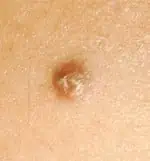
If you or your child was born with a mole, it is considered a birthmark. The medical term for it is “congenital nevus.” This type of mole is permanent. Congenital nevi occur in about 1% of the population.
Moles are typically small, round spots – about the size of a pencil eraser or smaller – although some may be larger. Moles can be tan, brown, or black. They may be flat or raised and have hair growing out of them.
Although the risk is low, a congenital nevus can develop into melanoma – the deadliest form of skin cancer – later in life. If you or your child has a mole that was present at birth, you should have it checked by a dermatologist at least once a year.
If you notice that a mole or freckle has a diameter of more than a pencil eraser or any characteristics of the ABCDEs of melanoma (see below), call your dermatologist to have the mole checked.
ABCDEs of Melanoma
Asymmetry. One half of the mole does not match the other half.
Border. The border or edges of the mole are ragged, blurred, or irregular.
Color. The color of the mole is not the same throughout or has shades of tan, brown, black, blue, white, or red.
Diameter. The diameter of a mole is larger than the eraser of a pencil.
Evolution. The mole is changing in size, shape, or color.
Vascular Birthmarks
Vascular birthmarks form when excess blood vessels clump together in a particular area of your skin. They occur in approximately 10% of all infants at birth or within the first few weeks of life. Some types of vascular birthmarks fade over time while others do not.
While they are harmless and painless, vascular birthmarks can cause concern for parents, and eventually for the child, especially if they are large or in a visible area.
Types of vascular birthmarks include salmon patch, hemangioma, and port wine stain.
SALMON PATCHES
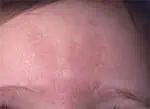
Salmon patches, with the medical name nevi simplex, are named for their color – reddish-pink like salmon. Those that occur on the forehead are nicknamed “angel’s kisses,” while those on the back of the neck are called “stork bites.” They may also occur on the eyelids, nose, upper lip, or back of the head.
They are commonly seen in 30 to 40% of newborns, especially around the neck, back of the hairline, forehead, area between the eyebrows, and along the lower back. Crying episodes, changes in environmental temperature, and breath holding are some of the changes that can briefly make these marks stand out more. Salmon patches on the back of the neck and head usually persist and are often covered by hair.
The most common type of vascular birthmark, salmon patches usually fade away by the time a child is 1 to 2 years old, although some last into adulthood.
HEMANGIOMAS
Hemangiomas are noncancerous growths that form due to an abnormal collection of blood vessels. The term hemangioma (infantile hemangioma) refers to a vascular lesion only evident in children. About 1 in 19 children will develop one. Hemangiomas are more common in Caucasians, twins, and females. Premature infants are also more likely to have a hemangioma.
Hemangiomas may be superficial or deep. Superficial hemangiomas, also called “strawberry hemangiomas,” appear on the surface of the skin as a bright red flat mark or raised bump. They may be present at birth or appear shortly thereafter. Most occur on the head or neck, although they can be anywhere on the body.
Deep hemangiomas, which appear after birth, are found below the skin’s surface. They are bluish-purple in color and make the skin swell and bulge.
Both types of hemangiomas grow rapidly during the first 6 months of life, but usually shrink and disappear by the time a child is 5 to 10 years old.
While most hemangiomas are harmless, some may require treatment. If a hemangioma interferes with sight, feeding, breathing, or other body functions, it will likely require treatment by a dermatologist. Treatment methods may include laser therapy, medication that may include corticosteroids, or surgical removal. Your dermatologist will advise you whether a hemangioma needs to be treated, as well as the best method of treatment.
PORT-WINE STAINS
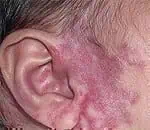
A port-wine stain is a type of birthmark that is caused by a malformation of tiny blood vessels called capillaries. The name port-wine stain comes from the color of the birthmark, which ranges from light pink to a dark red color. They start as flat, pink or red patches, and tend to become darker and grow along with the baby. Port-wine stains do not fade.
Because they can darken and grow over time, port-wine stains can affect a child physically and emotionally. Those that occur near the eye may cause eye problems, including glaucoma. In addition, some seizure disorders may be associated with port-wine stains. For these reasons, it is important to have a dermatologist evaluate your baby’s port-wine stain birthmark as early as possible.
Port-wine stains are not painful or itchy. It is sometimes difficult to tell the difference between a port-wine stain and other birthmarks, such as a salmon patch or a hemangioma, but your child’s doctor can diagnose it based on its appearance.
Your child’s doctor will likely advise you to wait and see how the patch develops; if a port-wine stain is very large or on the baby’s face, however, the doctor will likely recommend that your baby have further testing to make sure that there are no associated syndromes that might involve the brain or the baby’s development and will also recommend that you see a dermatologist in order to begin planning treatment.
Laser therapy is the typical treatment for port-wine stains. Laser treatment should begin within the first 6 to 12 months of life, and approximately 6 to 8 treatments are needed to obtain optimal results.
What To Do About Birthmarks
Most birthmarks are harmless and do not require treatment. Some, however, may be associated with other conditions or interfere with important body functions. In addition, larger birthmarks may leave behind a scar after they disappear.
If your child is born with a birthmark or develops one soon after birth, it is a good idea to have a dermatologist evaluate the birthmark to determine if treatment may be necessary.
Photo references:
(1) Photo used with permission of Journal of the American Academy of Dermatology, J Am Acad Dermatol 1999 June; 40(6):877-90. Copyright Elsevier (1999).
(2) Photos used with permission of the American Academy of Dermatology National Library of Dermatologic Teaching Slides.
(3) Photo used with permission of the American Academy of Dermatology National Library of Dermatologic Teaching Slides.
(4) Photo used with permission of Journal of the American Academy of Dermatology, 2007 Mar;56(3):353-70. Copyright Elsevier (2007).
(5) Photo used with permission of the Journal of the American Academy of Dermatology, 2008 Feb;58(2): S16-S22. Copyright Elsevier (2008).
(6) Photo used with permission of the Journal of the American Academy of Dermatology, 2009 April;60(4):669-75. Copyright Elsevier (2009).





